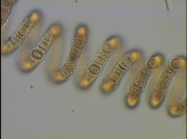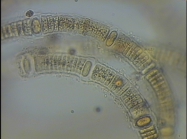RAS taxon details
Nodularia spumigena Mertens ex Bornet & Flahault, 1888
160566 (urn:lsid:marinespecies.org:taxname:160566)
accepted
Species
marine, fresh
Bornet, É.; Flahault, C (1886 '1888'). Revision des Nostocacées hétérocystées contenues dans les principaux herbiers de France (quatrième et dernier fragment). Annales des Sciences Naturelles, Botanique, Septième Série, 7: 177-262. [details]
Guiry, M.D. & Guiry, G.M. (2025). AlgaeBase. World-wide electronic publication, National University of Ireland, Galway (taxonomic information republished from AlgaeBase with permission of M.D. Guiry). Nodularia spumigena Mertens ex Bornet & Flahault, 1888. Accessed through: RAS (Eds.) (2025) Register of Antarctic Species at: https://ras.biodiversity.aq/aphia.php/aphia.php?p=taxdetails&id=160566 on 2025-09-12
RAS (Eds.) (2025). Register of Antarctic Species. Nodularia spumigena Mertens ex Bornet & Flahault, 1888. Accessed at: https://ras.biodiversity.aq/aphia.php?p=taxdetails&id=160566 on 2025-09-12
Date
action
by
2015-06-26 12:00:51Z
changed
db_admin
original description
Bornet, É.; Flahault, C (1886 '1888'). Revision des Nostocacées hétérocystées contenues dans les principaux herbiers de France (quatrième et dernier fragment). Annales des Sciences Naturelles, Botanique, Septième Série, 7: 177-262. [details]
context source (HKRMS) Nagarkar S .(1996). The ecology of intertidal epilithic biofilms with special reference to cyanobacteria. PhD thesis. The University of Hong Kong.Hong Kong. [details]
context source (RAS) Australian Antarctic Data Centre. , available online at https://data.aad.gov.au/aadc/biodiversity/ [details]
basis of record Guiry, M.D. & Guiry, G.M. (2025). AlgaeBase. <em>World-wide electronic publication, National University of Ireland, Galway.</em> searched on YYYY-MM-DD., available online at http://www.algaebase.org [details]
basis of record TMAP - Trilateral Monitoring and Assessment Program database, available online at http://www.waddensea-secretariat.org/TMAP/Monitoring.html [details]
additional source Muller, Y. (2004). Faune et flore du littoral du Nord, du Pas-de-Calais et de la Belgique: inventaire. [Coastal fauna and flora of the Nord, Pas-de-Calais and Belgium: inventory]. <em>Commission Régionale de Biologie Région Nord Pas-de-Calais: France.</em> 307 pp., available online at http://www.vliz.be/imisdocs/publications/145561.pdf [details]
additional source Silva, P. C.; Basson, P. W.; Moe, R. L. (1996). Catalogue of the benthic marine algae of the Indian Ocean. <em>University of California Publications in Botany.</em> 79: 1-1259., available online at https://books.google.be/books?hl=pt-PT&lr=&id=vtBdDwAAQBAJ&oi=fnd&pg=PR11&dq=Catalogue+of+the+benthic+marine+algae+of+the+Indian+Ocean&ots=FL-YOKu8Cx&sig=3PmT926F1rNHQTf1AhDeY-ztmu4#v=onepage&q=Catalogue%20of%20the%20benthic%20marine%20algae%20of%20the%20 [details]
additional source Guiry, M.D. & Guiry, G.M. (2025). AlgaeBase. <em>World-wide electronic publication, National University of Ireland, Galway.</em> searched on YYYY-MM-DD., available online at http://www.algaebase.org [details]
toxicology source McGregor, G. B.; Stewart, I.; Sendall, B. C.; Sadler, R.; Reardon, K.; Carter, S.; Wruck, D.; Wickramasinghe, W. (2012). First Report of a Toxic Nodularia spumigena (Nostocales/ Cyanobacteria) Bloom in Sub-Tropical Australia. I. Phycological and Public Health Investigations. <em>International Journal of Environmental Research and Public Health.</em> 9(7): 2396-2411., available online at https://doi.org/10.3390/ijerph9072396 [details]
context source (HKRMS) Nagarkar S .(1996). The ecology of intertidal epilithic biofilms with special reference to cyanobacteria. PhD thesis. The University of Hong Kong.Hong Kong. [details]
context source (RAS) Australian Antarctic Data Centre. , available online at https://data.aad.gov.au/aadc/biodiversity/ [details]
basis of record Guiry, M.D. & Guiry, G.M. (2025). AlgaeBase. <em>World-wide electronic publication, National University of Ireland, Galway.</em> searched on YYYY-MM-DD., available online at http://www.algaebase.org [details]
basis of record TMAP - Trilateral Monitoring and Assessment Program database, available online at http://www.waddensea-secretariat.org/TMAP/Monitoring.html [details]
additional source Muller, Y. (2004). Faune et flore du littoral du Nord, du Pas-de-Calais et de la Belgique: inventaire. [Coastal fauna and flora of the Nord, Pas-de-Calais and Belgium: inventory]. <em>Commission Régionale de Biologie Région Nord Pas-de-Calais: France.</em> 307 pp., available online at http://www.vliz.be/imisdocs/publications/145561.pdf [details]
additional source Silva, P. C.; Basson, P. W.; Moe, R. L. (1996). Catalogue of the benthic marine algae of the Indian Ocean. <em>University of California Publications in Botany.</em> 79: 1-1259., available online at https://books.google.be/books?hl=pt-PT&lr=&id=vtBdDwAAQBAJ&oi=fnd&pg=PR11&dq=Catalogue+of+the+benthic+marine+algae+of+the+Indian+Ocean&ots=FL-YOKu8Cx&sig=3PmT926F1rNHQTf1AhDeY-ztmu4#v=onepage&q=Catalogue%20of%20the%20benthic%20marine%20algae%20of%20the%20 [details]
additional source Guiry, M.D. & Guiry, G.M. (2025). AlgaeBase. <em>World-wide electronic publication, National University of Ireland, Galway.</em> searched on YYYY-MM-DD., available online at http://www.algaebase.org [details]
toxicology source McGregor, G. B.; Stewart, I.; Sendall, B. C.; Sadler, R.; Reardon, K.; Carter, S.; Wruck, D.; Wickramasinghe, W. (2012). First Report of a Toxic Nodularia spumigena (Nostocales/ Cyanobacteria) Bloom in Sub-Tropical Australia. I. Phycological and Public Health Investigations. <em>International Journal of Environmental Research and Public Health.</em> 9(7): 2396-2411., available online at https://doi.org/10.3390/ijerph9072396 [details]
 Present
Present  Inaccurate
Inaccurate  Introduced: alien
Introduced: alien  Containing type locality
Containing type locality



